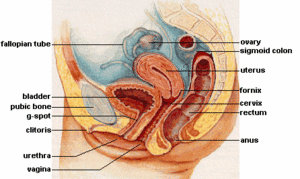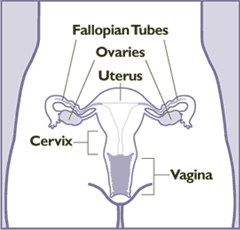Cervix
|
|
Cervix.jpg
The cervix (from Latin "neck") is actually the lower, narrow portion of the uterus where it joins with the top end of the vagina. It is cylindrical or conical in shape and protrudes through the upper anterior vaginal wall. Approximately half its length is visible; the remainder lies above the vagina beyond view.
| Contents [hide] |
Anatomy
Ectocervix
The portion projecting into the vagina is referred to as the portio vaginalis or ectocervix. On average, the ectocervix is 3 cm long and 2.5 cm wide. It has a convex, elliptical surface and is divided into anterior and posterior lips.
External Os
The ectocervix's opening is called the external os. The size and shape of the external os and the ectocervix varies widely with age, hormonal state, and whether the woman has had a vaginal birth. In women who have not had a vaginal birth the external os appears as a small, circular opening. In women who have had a vaginal birth, the ectocervix appears bulkier and the external os appears wider, more slit-like and gaping.
Endocervical Canal
The passageway between the external os and the uterine cavity is referred to as the endocervical canal. It varies widely in length and width, along with the cervix overall. Flattened anterior to posterior, the endocervical canal measures 7 to 8 mm at its widest in reproductive-aged women.
Internal Os
The endocervical canal terminates at the internal os which is the opening of the cervix inside the uterine cavity.
Cervical Mucus
Normally the external os is blocked by a thick mucus that prevents infection, however the mucus thins when ovum are ready to be fertilized, allowing spermatazoa to pass through the cervix. Most oral_contraceptives increase their effectiveness by not allowing this mucus to thin, therefore blocking spermatazoa from passing even when ovum are ready to be fertilized. During pregnancy the cervix is completely blocked by a special antibacterial mucosal plug which prevents infection as before. The mucous plug comes out as the cervix dialates in labor or shortly before.
Functionality
During orgasm, the cervix convulses and the external os dilates in such a way as to draw any semen in the vagina into the uterus. This is thought to increase the likelihood of conception.
During menstruation the cervix stretches open slightly to allow the endometrium to be shed. This stretching is believed to part of the cramping pain that many women experience. Evidence for this is given by the fact that some women's cramps subside or disappear after their first baby because the cervical opening has widened.
During childbirth, contractions of the uterus will dilate the cervix up to 10cm in diameter to allow the child to pass through.
Cervical cancer
In humans the cervix is associated with cervical cancer, a particular form of cancer which is detectable by cytological study of epidermal cells removed from the cervix in a process known as the pap smear.
Lymphatic Drainage
The lymphatic drainage of the cervix is along the uterine arteries and cardinal ligaments to the parametrial, external iliac, internal iliac, obturator, and presacral lymph nodes. From these pelvic lymph nodes, drainage then proceeds to the paraaortic lymph nodes.
| Reproductive system |
| Female: Cervix - Clitoris - Clitoral hood - Fallopian tubes - Bartholin's glands - G-spot - Hymen - Mammary glands - Ovaries - Skene's glands - Urethra - Uterus - Vagina - Vulva |
| Male: Bulbourethral glands - Cowper's glands - Ejaculatory duct - Epididymis - Foreskin - Frenulum - Penis - Prostate - Scrotum - Seminal vesicles - Spermatic cord - Testes - Urethra - Vas deferens |


